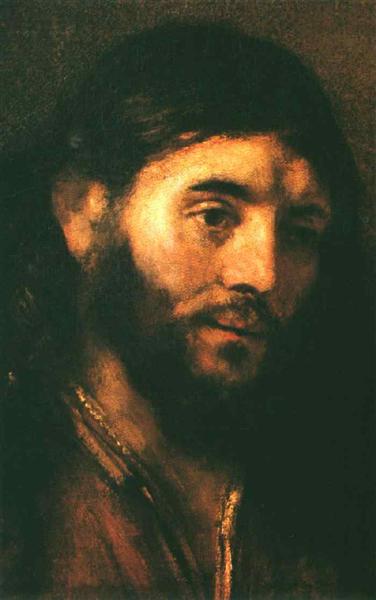Kuvaus
Vuonna 1650 päivätty Rembrandtin "Kristuksen päällikkö" kapseloi hollantilaisen maalarin hallinnan jumalallisen esittämiseen ihmiskunnassa. Tämä maalaus on poikkeuksellinen tutkimus Kristuksen hahmosta, jolle on ominaista sen karkea kauneus ja syvä henkinen itsetutkimus. Tässä työssä Rembrandt käyttää etualaista lähestymistapaa, joka rohkaisee katsojaa melkein läheiseen pohdintaan Kristuksen elämästä ja kärsimyksestä, poistamaan laajemman narratiivisen kontekstin hahmon ja sallii henkilön olemuksen loistaa.
Yksi tämän työn merkittävimmistä näkökohdista on valon laatu, Chiaroscuron hoito ja Rembrandtin kyky mallintaa ihmismuotoja. Pehmeä valo valaisee Kristuksen kasvoja korostaen hänen ilmaisunsa rauhallisuutta ja aatelisuutta. Chiaroscuron käyttö ei vain luo kolmen ulottuvuuden vaikutusta, vaan myös infusoi itsehavainto- ja meditaatiota. Valo näyttää lähtevän sisätiloista, vahvistaen jumalallisen ajatusta, kun taas vaippaavat varjot viittaavat kärsimyksensä ja uhrauksensa emotionaaliseen monimutkaisuuteen.
Värillä on myös perustavanlaatuinen rooli tässä työssä. Rembrandt käyttää lämpimiä sävypalettia, joka sisältää ruskeaa, kultaa ja syvempiä varjoja, jotka antavat maalille melkein tuntuvan laadun. Kristuksen iho on melkein kirkas toisin kuin tumma tausta, joka korostaa sen taivaallista luonnetta ja ihmiskuntaa. Tämä valon ja varjon suhde sekä värien valinta paljastaa taiteilijan teknisen taiton lisäksi myös sen kyvyn välittää emotionaalisen ja henkisen kertomuksen.
Ilmaus Kristuksen edessä on toinen ominaisuus, joka ansaitsee huomion. Se heijastaa surua, myötätuntoa ja eroamista sekoitusta, joka kehottaa katsojaa yhteyteen ihmisyyteen. Muiden hahmojen puuttuessa lähestymistapa keskittyy täysin tähän keskushahmoon, mikä mahdollistaa tunteiden syvän pohdinnan ja jumalallisuuden olemuksen.
Historiallisesti Rembrandtille on tunnustettu kyvystä yhdistää pyhät arkielämän kanssa. Hänen sitoutumisensa ihmisen tunteiden totuudenmukaiseen esitykseen, jopa jumalallisissa luonteissa, on ollut hänen teoksensa erottuva piirre. "Kristuksen päällikkö" lisää hänen lukuisia tulkintoja kristillisestä teemasta, jossa hän tutkii näkyvän ja näkymättömän, maaston ja taivaallisen välistä yhteyttä. Tämä teos heijastaa taiteellisessa tuotannossaan ajanjaksoa, jolloin Rembrandt syvenee yhä enemmän olemassaolon mysteerissä, melankolian tunnetta, joka on tuntuvaa monissa sen myöhemmissä maalauksissa.
Tämän maalauksen konteksti on myös merkittävä. 1650 -luku oli Rembrandtin henkilökohtaisten ja ammatillisten muutosten aika, joka oli merkitty tappiolla ja itsehavainnolla. Tätä työtä voidaan pitää heijastavana kyseisestä sisäisestä hausta, ja sitä voidaan tulkita todistuksena hänen halustaan ymmärtää perusteellisesti Kristuksen hahmo paitsi uskonnollisen perinteen, myös oman elämänkokemuksensa kautta.
Lyhyesti sanottuna "Kristuksen pää" ei ole vain kuvatekniikan mestariteos, vaan myös syvä meditaatio ihmisen tilasta ja jumalallisesta. Rembrandt onnistuu ainutlaatuisen lähestymistavan kautta Kristuksen hahmoon ylittämään ajan ja kehottaa katsojaa ilmoittautumaan läheiseen vuoropuheluun hänen taiteensa kanssa, joka resonoi edelleen kaikilla emotionaalisilla ja hengellisillä painoillaan vuosisatoja sen luomisen jälkeen.
KUADROS ©, kuuluisa maali seinällesi.
Käsintehty öljymaalaukset, ammatillisten taiteilijoiden laadun ja erottuvan sinetin kanssa KUADROS ©.
Kuvien jäljennöspalvelu tyytyväisyystakuu. Jos et ole täysin tyytyväinen maalauksen jäljennökseen, palautamme rahasi 100%.

